![]()
|
|
|
|
|
Stoke-on-Trent - photo of the week |
Advert of the Week
Potworks of the Week
Roman Catholic Church of St.
Joseph, Hall Street, Burslem
In the years following the
Catholic Emancipation Act of 1829, Roman Catholic centres of worship
began to appear. Many of the early ones were enlarged or rebuilt as
their congregations grew and finances permitted. Outstanding among this
later generation of churches are Sidney Brocklesby's splendid
twentieth-century duo of the Sacred Heart, Tunstall and St. Joseph's,
Burslem.
|

Roman Catholic Church of St.
Joseph, Hall Street, Burslem - 'the church of genuflexions'
picture: © Matthew Rice - The Lost City of Stoke-on-Trent
| 'In front, on a little hill
in the vast valley, was spread out the Indian-red architecture of
Bursley--tall chimneys and rounded ovens, schools, the new scarlet
market, the grey tower of the old church, the high spire of the
evangelical church, the low spire of the church of genuflexions, and the
crimson chapels, and rows of little red houses with amber chimney-pots,
and the gold angel of the blackened Town Hall topping the whole. The
sedate reddish browns and reds of the composition, all netted in flowing
scarves of smoke, harmonized exquisitely with the chill blues of the
chequered sky. Beauty was achieved, and none saw it.''
Arnold Bennett - Clayhanger |

The two west towers; one
square in plan and one smaller and round

Central wide arched
entrance in western gable
"using the decorative properties of brick to enrich the
facades with herringbone tiled courses"
The church would not be at all
out of place if it was picked up and move to
some sunny square in Rome or Florence.
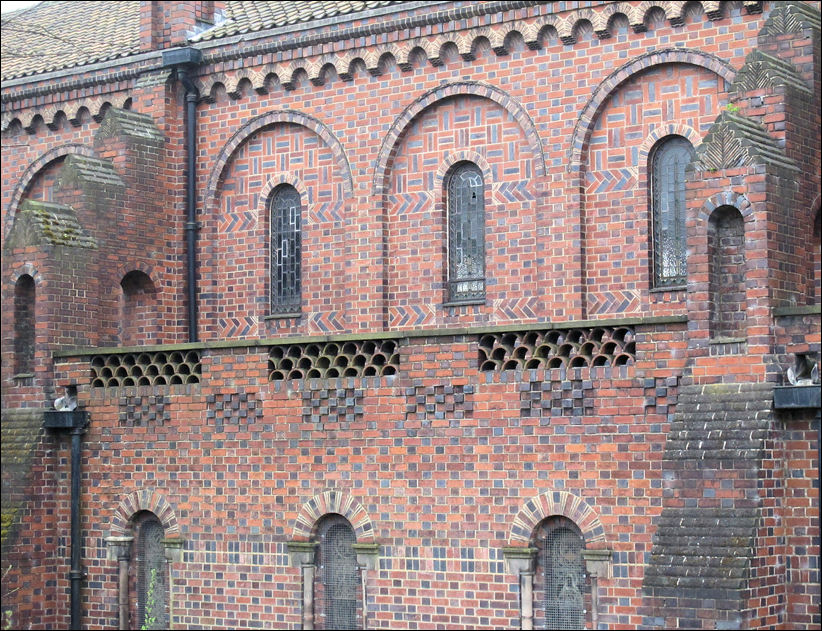
Italianate style, using the decorative properties of brick to enrich the
facades with herringbone tiled courses etc.

detail on the front of the
round tower
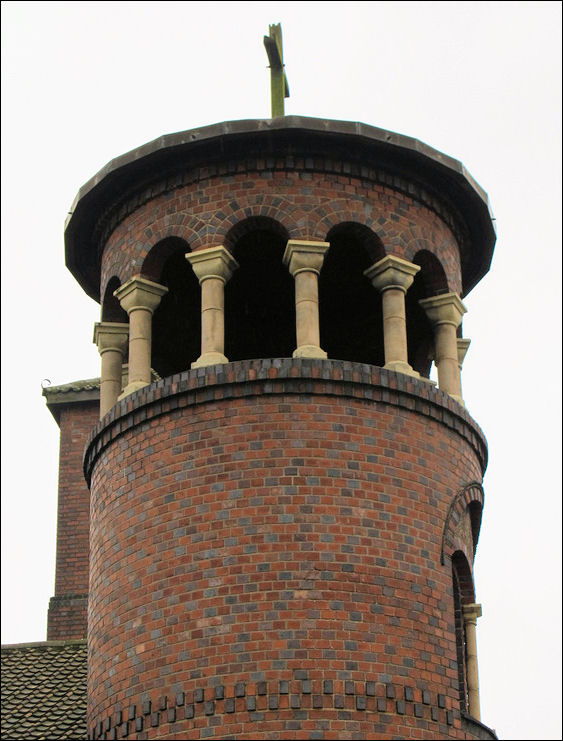
round southwest tower with
conical roof over open arcade
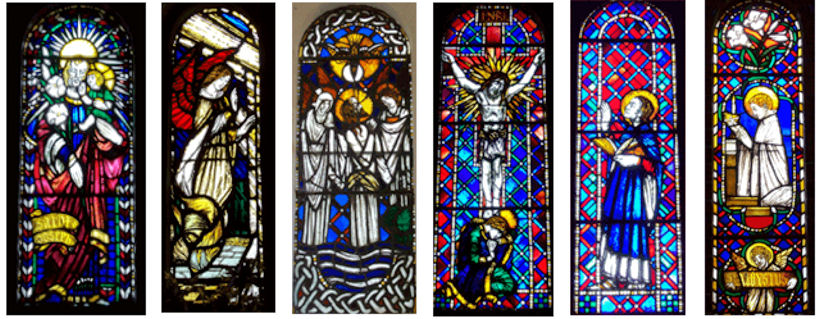
six of the 32 stained glass
windows in St. Joseph's - designed by Gordon Forsyth and made by some of the
church members
photo: Friends of St. Joseph's
| The M.P. for Burslem ath
the time - Andrew MacLaren, suggested to the parish priest Fr. Browne, that working people should make the decoration for the church. Renowned artist and superintendent of Stoke-on-Trent art education Gordon Forsyth agreed to teach young parishioners how to make 32 stained glass windows, designed by him. He also designed ceiling panels which were made by them. Gordon Forsyth was already a nationally recognised artist when he agreed to design windows for St. Joseph's. Burslem church was only a stone's throw away from Burslem School of Art where Forsyth was working. He and Fr Browne became great friends and Gordon Forsyth advised on other artistic matters in the church. Soon Forysth's daughter Moira was producing artwork for the church. |
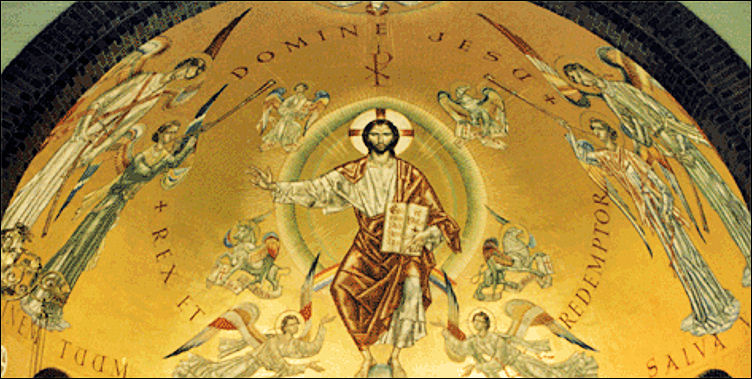
the hugh ceiling painting
'Christ in Glory' was produced by Gordon Forsyth's daughter Moria
photo: Friends of St. Joseph's
| Moira Forsyth produced the huge ceiling painting 'Christ in Glory' in panels in her London studio, circa 1935-37. In later years Moira became a highly respected stained glass window artist and designed for many churches through the UK including Guildford Cathedral, Norwich Cathedral, Eaton College, St. Columbas church in London. |
| Father
and daughter left legacy to Mother Town
St Joseph's rose from the ruins of an old pottery factory. Father Browne even got the men to demolish the potbank first as they daily got stuck-in with pick and shovel. And as the church building grew, the newly appointed Burslem School of Art principal, Gordon Forsyth (1879-1952), watched with interest, as did the newly-elected Burslem MP Andrew MacLaren.
And so a bond was forged between the community, a politician, a priest and two artists. In 1945, Scotsman MacLaren lost his seat and left Burslem. He died in 1975 at the age of 82.
"And this is not just the view of a parish priest. Bernard Rackham, former keeper of ceramics at the Victoria & Albert Museum, valued Moira's work among the best he'd seen. She later received the Queen's Award for lifelong services to the arts. But among her finest work surely is the mural at St Joseph's in Burslem." Fred Hughes |
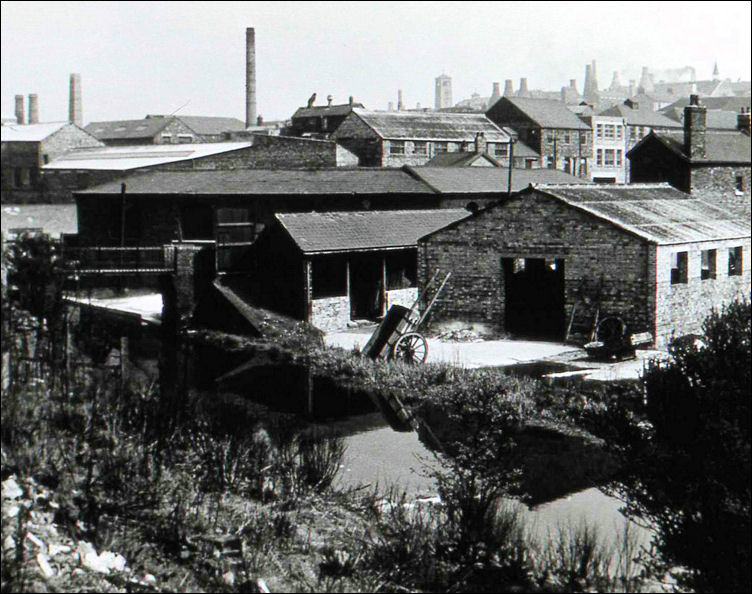
a cratemakers alongide the
canal - looking towards Dalehall and Burslem
on the horizon to the left of centre
is the tower of St. Joseph's RC Church, Burslem
a number of bottle kilns are also visible
photo: the Ewart Morris Collection

three listed buildings
|
In this photo there are three listed buildings: the façade of the Hill Top Sunday School, the Roman Catholic Church of St. Joseph and the Hill Top works. |

The style is Italian and the colours of the bricks, which were locally made at Fenton,
were chosen to reflect a herringbone pattern
|
related pages ‘In Praise of Father Ryan’ - Church of the Sacred Heart on Queens Avenue, Tunstall
external links.. Friends of St.Joseph's web site also see.. Advert
of the Week |